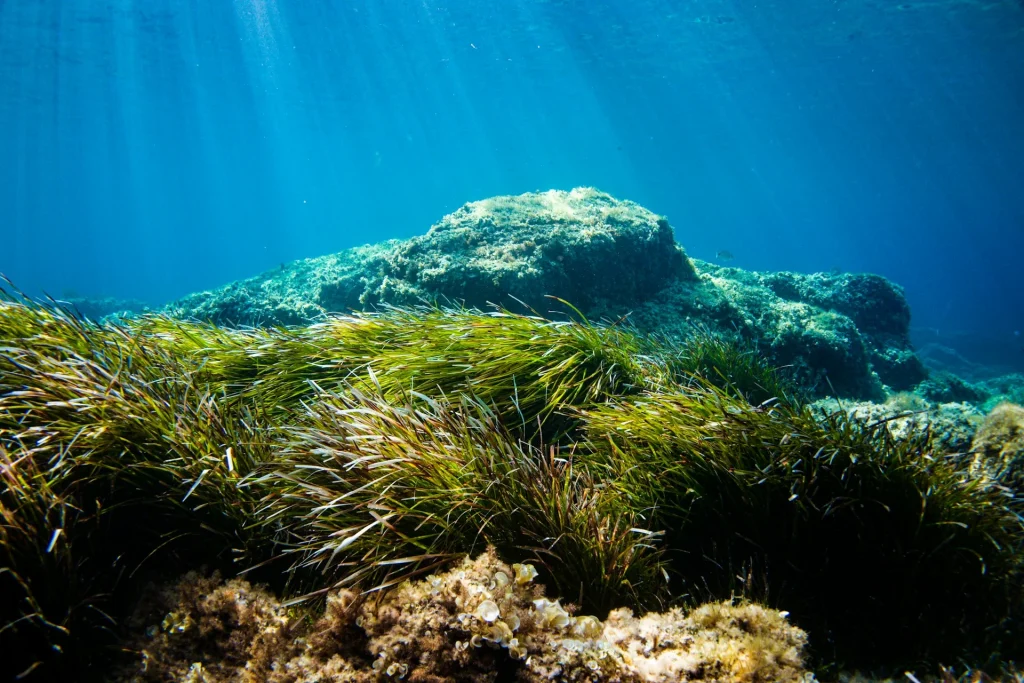Seagrass
Image credit: Benjamin-l-Jones on Unsplash
Seagrass is a type of flowering marine plant that grows in shallow coastal waters around the world. Unlike seaweed, which is an algae, seagrasses have roots, stems, and leaves, and they produce flowers and seeds. These underwater meadows are found in temperate and tropical regions, forming extensive underwater ecosystems vital to marine life.
Fascinating Facts About Seagrass
Seagrass meadows cover less than 0.2% of the ocean floor but produce 10% of the ocean’s carbon storage.
A single square meter of seagrass can generate up to 10 liters of oxygen per day.
Seagrasses date back around 100 million years, making them one of the oldest plant groups in the ocean.
They can capture carbon up to 35 times faster than rainforests, making them crucial in combating climate change.
Seagrass and Its Role in the Environment
Seagrass plays a critical role in maintaining the health of marine ecosystems by serving as a bridge between coral reefs and mangroves. These three habitats work together to create a thriving coastal ecosystem.
Carbon Sequestration: Seagrass meadows are excellent carbon sinks, trapping and storing large amounts of carbon dioxide, which helps mitigate climate change.
Coastal Protection: The roots of seagrasses help stabilize sediments, reducing coastal erosion and buffering shorelines from storm surges and waves.
Water Filtration: Seagrass traps sediments and excess nutrients, improving water clarity and reducing pollution.
Biodiversity Hotspot: Seagrass meadows provide shelter and food for a vast range of marine species.
The Decline of Seagrass Meadows
Key drivers of this decline include:
Coastal Development: Urban expansion, dredging, and land reclamation are destroying seagrass beds.
Pollution: Agricultural runoff, sewage discharge, and industrial waste lead to nutrient overloads, causing harmful algal blooms that suffocate seagrass.
Climate Change: Rising sea temperatures, ocean acidification, and extreme weather events weaken seagrass health.
Physical Damage: Boating activities, trawling, and anchoring disturb the fragile structure of seagrass meadows.
If current trends continue, the loss of seagrass meadows will have devastating consequences for marine biodiversity, carbon storage, and coastal protection.
Did You Know?
Seagrass meadows are disappearing at an alarming rate. Studies estimate that global seagrass coverage has declined by approximately 29% since the late 19th century, with an annual loss rate of around 1.5% in recent decades. Some regions have lost over 50% of their seagrass due to human activities and environmental changes.
Image credit: Geoff Trodd on Unsplash

Species That Depend on Seagrass
Many marine species rely on seagrass meadows for survival. Some key species include:
Green sea turtles (Chelonia mydas) – Feed on seagrass, maintaining its health by preventing overgrowth.
Dugongs (Dugong dugon) – Often called ‘sea cows,’ these marine mammals graze almost exclusively on seagrass.
Seahorses (Hippocampus spp.) – Use seagrass as a hiding place from predators and as a breeding ground.
Manatees – Like dugongs, they depend on seagrass for their diet.
Various fish species – Juvenile fish such as groupers and snappers use seagrass meadows as nurseries before moving to deeper waters.
Image credit: Harry Jaschhof on Unsplash
Benefits of Seagrass to Humans
Fisheries Support: Seagrass meadows serve as nurseries for many commercially important fish species, supporting livelihoods and food security.
Tourism and Recreation: Healthy seagrass meadows enhance marine tourism by supporting activities like snorkeling and diving.
Climate Change Mitigation: By storing carbon, seagrass plays an essential role in reducing greenhouse gas levels in the atmosphere.
Threats to Seagrass Ecosystems
Despite their importance, seagrass meadows are declining at an alarming rate due to:
Coastal Development: Construction, dredging, and land reclamation destroy seagrass habitats.
Pollution: Runoff from agriculture and urban areas leads to excessive nutrients, which cause algal blooms that smother seagrass.
Climate Change: Rising ocean temperatures, sea level changes, and increased storm activity threaten seagrass meadows.
Physical Damage: Boat anchors, propeller scars, and destructive fishing methods can uproot and kill seagrass beds.
Final Words
Seagrass may not always be in the spotlight, but its ecological importance cannot be overstated. By supporting marine biodiversity, acting as a natural carbon sink, and protecting coastlines, seagrass meadows are vital to the health of our oceans. Through conservation efforts and sustainable practices, we can ensure that these underwater meadows continue to thrive for generations to come.

